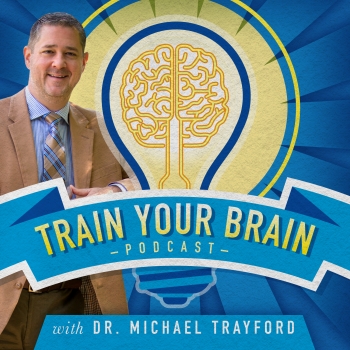Podcast: Play in new window | Download

Good morning and welcome to Episode 75 of the Train Your Brain Podcast with Dr. Michael Trayford. Every Monday we produce a 30-minute episode. Tuesday through Sunday we produce episodes with five-minute tips. Every episode of the Train Your Brain Podcast features a tip, so you can receive pointers 365 days a year that will help enhance the performance of your brain!
This morning Dr. Trayford shares tip number 75. So … diet soda is part of a healthy balanced diet? Sorry to break it to you, but diet soda is nowhere to be found in a healthy balanced diet. These artificial sweeteners so readily consumed in the name of cutting excess sugar from the diet are quite harmful. Controversy swirls around this issue, we know, but please search out unpaid research and look for yourself. Artificial sweeteners are likely to cause hypertension and a host of other problems to the brain and body down the line.
This tip relates to a pretty hot topic. Everywhere you go you see people drinking diet sodas and you see stores stocking less and less of the sugar sweetened products. There is a line of good reason, thinking that this might not be the best thing.
There’s a lot of controversy and a lot of money to be made in this business, so nobody is going to go down without a fight. Charge is coming from all different directions to help educate people on what is and isn’t good for them. The beverage industry is coming out saying that these drinks are absolutely safe for you and they have the evidence to prove it. At the same time there are all these other groups coming out saying that all of these artificial sweeteners are not good for you. I’m picking on soft drinks, but this topic extends to artificial sweeteners that are found in many other products.
Because what is it everyone is trying to avoid?
Jason: Sugar!
Absolutely. Sugar is seen as the enemy.
Everything becomes such a fad. In the 80’s the prevailing thought was that it was fat that was bad. So they started putting so much sugar into these foods that a lot of people ended up getting diabetes.
Ultimately, you can’t take one element out of foods and expect it to be productive. Obviously a lot of marketing power and clout comes behind these movements and people make large amounts of money on these trends.
The prevailing thought for the last four or five years now has been to cut back or cut out sugar. There are several diet plans, like the Paleo diet that tries to completely cut out sugar. Not to pick on any one diet plan. But eliminating a single food group can have consequence.
In certain cases, you might see these extreme diets being recommended for people with specific medical conditions. The Ketogenic diets are sometimes recommended to help people with seizure disorders.
As we’ve talked about in the past, our nerve cells need sugar on a constant basis for them to fire effectively. And nerve cells don’t have the ability to store sugar.
We want to focus on high fiber complex carbohydrates, such as fruits and vegetables with an edible peel like apples, plums and pears. You want to avoid things like a piece of store bought chocolate or ice cream that have a lot of refined sugar and no nutritional value.
A lot of people have heard of saccharine, then there’s Sucralose and aspartame, these are the more common artificial sweeteners you most commonly see in use in soft drinks.
These sweeteners have been under intense scrutiny for decades. And just the fact that they’re under scrutiny is question enough to avoid them. Just the fact that they are drawing so much attention means there is probably enough going on to avoid them altogether.
Some of them have been linked to the occurrence cancer, heart disease and diabetes and neurotoxicity or nerve degeneration. The artificial sweeteners I mentioned are FDA approved with acceptable levels.
Which is another red flag that says these sweeteners might not be so good for you. So there are these acceptable daily intake levels assigned to artificial sweeteners. So again intense scrutiny and they are telling us to take them in small amounts. This alone should be enough of a warning not to consume these products.
But in this 140 character message society that we live in, everyone is reading bits and bites of what’s bad. The idea that you can drink a can of diet soda to lose weight, as we are understanding is not the case.
The brain is being tricked into thinking that there’s food on board when there’s not. So we can actually run into issues with malnutrition when we consume these artificial sweeteners, because the brain is being tricked. Your pituitary gland and other parts of your body is being tricked into thinking that there’s food on board when there’s not.
So then we tend to under eat, or when we do eat we indulge in too many sugars which causes your body to store more body fat.
If you’re drinking these beverages on a regular basis. I don’t want you to get mad at me. But it’s still worth looking around at some of the research and scrutiny surrounding these beverages and foods with artificial sweeteners. Try not to look at the research put forth by manufacturers because they tend to publish these reports with their own marketing messages.
These artificial sweeteners have even been found to be neuro-toxic. Meaning they can have a negative impact on nerve cells being able to communicate with one another.
If you have any concerns regarding the information and applications discussed in this podcast, please consult your physician and a doctor who is experienced in functional neurology. Michael Trayford DC, DACNB is available for consultation by calling (828) 708-5274. Thanks for listening. Continue reading →


